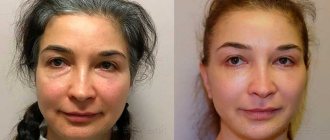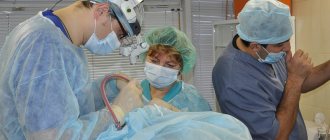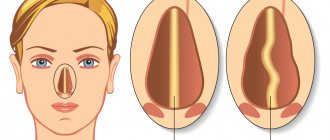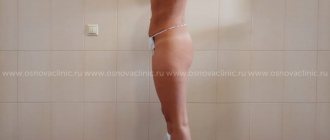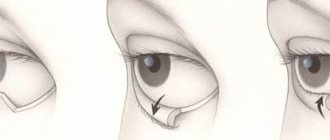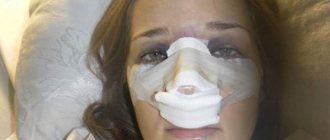Before deciding to correct the shape of your ears, you should evaluate the need for the procedure. The reasons for refusing surgery can be different - from medical contraindications to the low need for the correction itself.
Otoplasty is considered a simple operation and is performed on an outpatient basis under local anesthesia. The manipulations do not take much time, and the rehabilitation process is not difficult. Each patient chooses whether to undergo otoplasty or not.
How is otoplasty performed?
To correct the ears, an incision is made along the back surface of the auricle. The ear cartilage is isolated and dissected, onto which incisions are applied. In this case, the cartilage takes a new shape, which will ensure the position of the auricle after surgery. Absorbable sutures are placed on the cartilage. After removing excess skin along the back surface of the auricle, the wound is sutured with an intradermal suture. The skin incision and postoperative scar are located in the natural fold of skin behind the ear and remain invisible to others after complete healing.
In what cases should otoplasty be done?
Otoplasty allows you to make adjustments to the appearance of your ears. With the help of surgery, you can change the shape of the lobes or reduce them, correct protruding ears and achieve symmetry of the face in case of different shapes. Otoplasty can also correct macrotia, a condition where the patient has disproportionately large ears. In rare cases, a doctor is consulted to correct a previous unsuccessful operation.
The correction is permissible for both adults and children. The main thing is that the client does not have life-threatening diseases or ear infections. For children, it is important that the ear cartilage is strong enough for surgery.
Before prescribing the procedure, the patient must be examined by a doctor. This is necessary to reduce the risk of side effects and complications. In some cases, surgery may be denied.
Most often this is due to the presence of the following diseases:
- bleeding disorders;
- high blood sugar;
- inflammatory processes in the ear;
- hepatitis A;
- AIDS.
Also, the reason for refusal may be the presence of an infectious disease or a malignant tumor. In addition, you should refrain from surgery if you are prone to the formation of keloid scars.
Postoperative period:
After otoplasty, the patient can be discharged from the clinic within 2-3 hours. After the operation, slight swelling and intradermal hemorrhages are observed - this is a natural reaction of the body to surgical intervention and you should not be afraid of it. The swelling decreases and completely disappears by 7-10 days. After otoplasty, the patient will need to wear a special fixing bandage for a week and perform dressings. Intradermal sutures are removed on the 7-10th day. If necessary, in the postoperative period, our plastic surgeon will prescribe painkillers and antibiotics, recommend visits to a cosmetologist and special anti-scar agents. The total duration of the recovery period will be 7-10 days. After this, the patient can begin daily life and the child can attend school.
EAR PLASTY / OTOPLASTY
The cost of the procedure is from 32,000 ₽.
Otoplasty is the surgical elimination of congenital or acquired (traumatic) ear defects.
This operation is one of the most common in plastic surgery and allows you to adjust the size of the ears, their shape and location relative to the face. The technical execution of operations consists of using one of two main methods:
- Making a skin incision on the back of the ear. Separating (separating) the skin from the perichondrium (perichondrium). Thus, the surgeon provides himself with access to the cartilage of the auricle and begins to model it, that is, to change the shape, reduce the thickness and resect excess cartilage tissue. If necessary, the location of the cartilage is changed, followed by fixation with sutures, thereby achieving a more natural appearance of the auricle. It is the sutures placed on the cartilage that make it possible to form an antihelix fold and correct the shape of the auricle. These sutures remain forever, and the external ones are removed on the 10th day.
- Removal of a section of skin in the area behind the ear, bending of the cartilage in the posterior direction without partial resection. After this, the cartilage is fixed with guide sutures in the selected position.
Indications
- Elimination of “protruding ears” (protruding ears)
- Correction of large auricles and lobes
- Rolled up ear
- Ear asymmetry
- Ear reconstruction after trauma (various deformities, including ruptures)
- Psychological discomfort
Contraindications
- Acute or chronic diseases in the acute stage
- Diabetes
- Oncological diseases
- Diseases associated with bleeding disorders
- For women - the period of the menstrual cycle
Operation time
1-2 hours
Anesthesia
Local/general
Primary rehabilitation (sutures, swelling, hospital).
Hospital: up to 1 hour / 1 day
Removal of sutures: on the 10th day
Swelling: 7-14 days.
It is mandatory to wear a compression bandage for 20 days (the first 10 days around the clock, the next 10 days - exclusively at night).
Complete rehabilitation
The final assessment of the results of the operation is made after 3 months.
Limitations of the rehabilitation period
- It is better not to wash your hair before the stitches are removed to prevent the risk of infection.
- After otoplasty, sleep only on your back, it is better to raise the head of the bed
- Physical activity in the early rehabilitation period should be completely excluded to prevent increased pressure, suture dehiscence and the formation of scars in their place.
- Visits to saunas, baths, and swimming pools are limited to 1 month.
- Protection from ultraviolet rays until the scar is completely formed.
Postoperative dressing
The bandage, which must be worn during the rehabilitation period after otoplasty, reliably holds both conchae in the correct position. In addition, it is necessary to prevent their displacement before the tissue healing process begins.
This product copes well with the following tasks:
- protects ears from injury;
- prevents the spread of hematomas and edema that usually form in the operated area.
Note that the bandage after otoplasty has a very convenient feature. Manufacturers produce it in the so-called universal size. But it fits on any head, as it is equipped with a special clasp.
What does it look like
This medical accessory has a ring shape. In essence, this is a simple bandage - elastic or ordinary. If desired, it is permissible to wear a bandage instead.
Today you can buy a special head bandage in pharmacies or specialized medical equipment stores. In terms of characteristics, it is no different from a compression bandage after otoplasty. But it looks much more presentable.
This accessory is very similar to the headband that athletes usually wear. It can often be seen, for example, on tennis players. It differs, as already mentioned, only in the presence of an adjustable fastener (Velcro).
Duration of wearing
Many people are interested in how long they will have to wear the bandage. As a rule, the doctor recommends walking in it for at least a week. The maximum period is 14 days. This accessory can only be removed with the permission of a doctor.
After the doctor has put a compression bandage on the patient, the patient can go home. True, then he will need to make a few more visits to the clinic so that the surgeon can monitor how the rehabilitation is going and make dressings.
It is necessary to change the bandage. This is necessary to maintain hygiene and prevent the development of pathological processes.
The patient must be bandaged at least twice:
- The next day after surgery. At the same time, the doctor evaluates the work done.
- On day 8. The stitches are removed. The surgeon carefully examines the ears and gives recommendations for care.
Proper wearing of a compression bandage after otoplasty and compliance with all rehabilitation rules will largely determine the cosmetic effect of the intervention.
Stages of rehabilitation
Typically, after otoplasty is performed, recovery begins within a couple of hours. Immediately after the operation, the ears are fixed with a special plaster, a cotton compress with a healing agent is applied to them, and a tight elastic bandage around the head maintains the correct position. The entire rhinoplasty rehabilitation period is divided into several key stages.
- First day. This watch is the most complex. Firstly, severe weakness is still felt if general anesthesia was used. Secondly, pain and discomfort during this period are the strongest. In order to reduce them, medications are usually prescribed. The next day, if the doctor is convinced that everything is going well, after examination and dressing, you can return home.
- Dressings. A very important point that should not be missed. The first dressing is done on the second day. It is the most painful, but necessary to ensure that recovery after rhinoplasty goes faster. The second is performed on day 3-4. During this procedure, the seams are processed, cotton swabs and bandages are removed, and only a fixing headband remains. It is advisable to spend the entire period before the stitches are removed at home. You need to sleep on your back, do not touch your ears with your hands and avoid getting water under the bandage, so it is better not to wash your hair for now.
- Removing stitches. If the sutures are self-absorbing, they are usually removed on day 7. By this time, bruises and swelling have time to subside, and pain completely disappears. To make recovery after otoplasty faster, it is better to limit your salt intake. It retains fluid in the body and slows down the disappearance of edema. After removing the stitches, you can take a shower, but you should still not take hot baths or swim in the pool or open water.
- Primary recovery. Active recovery is completed 2 weeks after surgery. At this time, you can go to work and return to your normal lifestyle. For another month you will have to give up active physical activity, visiting a solarium, playing sports and prolonged exposure to the open sun. It is not recommended to wear hats that tighten the head, or to touch the ears with your hands unnecessarily.
- Full recovery. Final recovery takes 3 to 4 months. After this period, the consequences of otoplasty can be fully assessed. The ears take on a beautiful new shape. It is already allowed to play sports, sunbathe, swim and lead an active lifestyle.
It is advisable to avoid playing ball, contact martial arts and other sports in which the ears can be injured.
How is otoplasty performed?
Otoplasty is one of the few plastic surgeries that are successfully performed under local anesthesia.
It takes from 30 minutes to 2 hours, depending on the degree of difficulty. Virtually no preliminary preparation is required. But in order to make sure there are no medical contraindications that can cause various complications, you will have to undergo a series of laboratory tests. The incisions are made with a regular or laser scalpel behind the ears, where they will subsequently become completely invisible. After all necessary manipulations have been completed, the incision sites are closed with cosmetic sutures. How long rehabilitation after otoplasty lasts largely depends on the individual characteristics of the body, as well as on the amount of correction performed.
How is the operation performed?
Before the operation begins, the patient undergoes an examination and preparatory procedures. Then the doctor gives local anesthesia so that there is no pain. Then they make a small incision and penetrate into the ear cavity. If necessary, implants are installed. To restore the eardrum, tissue from the ear itself is used. In total, the operation takes no more than 2 hours.
After tympanoplasty, a special bandage is applied to the ear. The patient will have to spend some more time in the clinic under the supervision of doctors. It will take several weeks for complete recovery. In the period after tympanoplasty surgery, you will have to comply with a number of restrictions so as not to worsen your own condition and not cancel out all the results.

